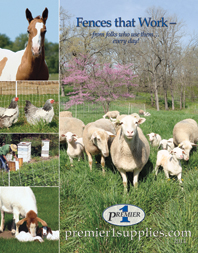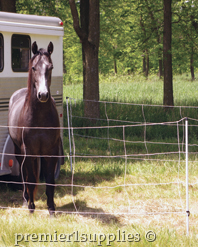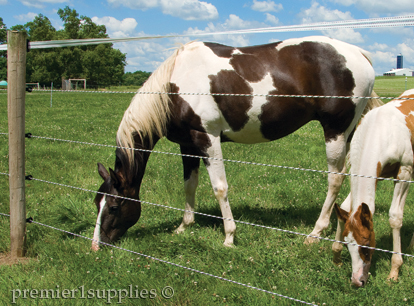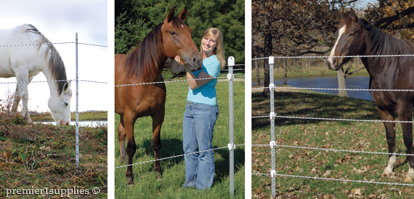NEW! FENCES THAT WORK BOOKLET
 New!
New!
2014 Fence Booklet
Look for it in your mailbox the week of March 17. It includes, along with our standard products, the following new items:
HotShock® & IntelliShock® Energizers
(Expected mid-April 2014.)
Low cost, new design! 0.5, 1, 2 and 3 joule units that use either battery or plug-in power. IntelliShock DC units are variable draw—that means they use less energy when the fence is clean, thus increasing battery life and reducing cost.
Insulators
| • |
Corner Roller—Prevents conductor from slipping off. Smooth roller prevents wear on conductors. Safer—plastic pin breaks if a horse crashes into fence. |
| • |
Double Pigtail Offset—Holds conductors on opposite sides of wooden post. For use with rope and narrow tape. Tolerates moderate up/down strain. |
PREMIER NETTING

Horse QuikFence™ works easily to build trailer paddocks. End posts are tied (with nonconductive strings) to the trailer for support. Use our AN90 Energizer to energize the fence.
Semi-Permanent Horse QuikFence™
Premier is the source of 80% of the USA's electric netting. And we're the world leader for new netting designs and uses!
Why Premier “knows” netting...
| • |
We’ve used it for 44 years (since 1970)—longer than anyone in the US. |
| • |
It’s in use 24/7 at Premier to fence sheep, goats, poultry and dogs in—and to fence deer, coyotes, and stray dogs out. |
| • |
We talk daily to netting users nationwide—who let us know what they like and/or dislike; when it works and when and why it doesn’t. |
| • |
View our Netting Comparison Chart to compare all of our nets. |
We have 3 netting videos available:
ENERGIZERS
PRS Solar Energizers
Which unit is right for you?
The size, in pulse energy output (range from .5 joule to 2 joules), depends almost entirely on the weed contact that will occur and the length of the fence.
Contact Premier or call 800-282-6631 to speak with one of our fence consultants to help you determine the best energizer for your needs. We have a unique 2-year rapid replacement warranty on all of our energizers.
You can also view our energizer comparison charts online or in Premier's fencing booklet to help in choosing an energizer.
|
 |
 |

Adding wide tape to a rope fence makes it more visible to young colts and fillies (whose desire to run occasionally exceeds their motivation to stop).
Before you buy or build a fence
Q. What is the fence’s location? Is it flat? Or does it go over hills and ditches and around curves? Is it covered with brush, trees or open grass? Are the soils rocky, very soft, sandy or firm?
A.The optimum fence design often hinges on answers to these questions.
Q. Do the animals know the fence?
A. Local animals and wildlife get to “know” a fence by appearance, location and “pain memory.” If it’s a strong or painful fence they avoid it. On the other hand new animals just off a truck often charge into permanent fences and straight through temporary or semi-permanent fences. That’s why strong, tall, visible permanent fences are essential for corrals and feedlots. Temporary fences that are not physically strong pose the greatest risk of escape to newly acquired animals. It pays to train them to it inside of a permanent fence.
Q. What specific animals need to be fenced in or out?
A. Always design and build for the most difficult species. Rules of thumb:
| • |
Most sheep and goat fences will stop cattle and horses. The inverse is not always true. |
| • |
Fencing adult males (bulls, rams, stallions, billies) in/out during breeding season requires taller fences with closer wire/strand spacing and more powerful electric pulses (in joules, not volts). |
| • |
Fences for mixed sizes (ewes with lambs, etc.) need more strands than uniform animal groups. |
| • |
Certain breeds need better fences (e.g. flighty Romanov sheep, tall Columbia sheep, Chianina cattle). |
Q. Should you energize the fence?
A. It pays to do this. Why?
| • |
A “hot” strand has a “zone of pain.” So fewer strands are needed if one is energized. Both the material and the labor to install is reduced. |
| • |
Energized fences last longer and require less maintenance—because animals do not crowd, rub or scratch on them. So the fence wires (including wires that are not energized) require less tension to do their job. And braces and corner posts will last longer. |
| • |
Animals are more surely contained or excluded during breeding and weaning. |
Q. How keen will animals be to breach the fence line?
A. Build for the worst-case situation (if you can afford to do so).
| • |
Hunger. Starved animals will eventually challenge most fences. |
| • |
Weaning. Strong physical barriers are needed. |
| • |
Breeding. Libido induces all creatures to challenge rules and especially fences. |
| • |
Boredom. Animals in corrals, stalls and feedlots crave any “entertainment” or activity. |
| • |
Gateways and handling yards. Animals often push each other into fences when being moved. |
| • |
Fear and fright. Predators or loud noises can cause “prey” species (e.g. horses, goats, turkeys) to run in terror straight into, under, over or through any fence, no matter what fence design (netting, high-tensile or woven wire). |
HORSE FENCE OPTIONS

Fence Solutions for Horses
Horse fence systems available:
| • |
Temporary (far left photo) — Rope or Tape |
| • |
Semi-Permanent (middle photo) — Horse QuikFence & Rope |
| • |
Permanent (far right photo) — Rope, Combination, Tape, Guard Strands and EquiLine Star |
Why our horse fences work...
Our fences are designed by the “horse folks” at Premier with the needs of both horse and horse owner in mind.
While cost is a consideration, it is not our first concern. More important is the safety to horse and rider, installation ease and reliability of the components.
Two important reminders:
| 1. |
Horses are powerful and respond to alarming situations by fleeing. The shorter, smaller and less visible a barrier, the more chance a horse may run into, through or over it. The taller, larger and more visible a horse barrier, the less likely this will occur. |
| 2. |
Risk, be it to horse, fence or horse owner, is inherent in the nature of horses and horse barriers. The risk can be reduced—via increased visibility and/or safer materials but risk can never be eliminated. |
Every fence must be easily seen by horses (and people)...
Because their eyes are on the sides of their heads, horses are less able than cattle or people to see small objects directly in front of them when running.
That’s why they occasionally run into steel wire fences—and in doing so, risk injury and/or escape. And escaped horses are serious road hazards.
Knowing this, we designed our ropes and tapes with the equine vision capabilities in mind. That’s why:
| 1. |
They have contrasting colors—to be visible against all backgrounds. (We were the first to offer black and white tapes and ropes. That we were right to do so has been proven by our many imitators.) |
| 2. |
They’re flexible and large enough in diameter that direct impact by a horse rarely results in injury. |
Why electric fences from other sources may not work as well...
| • |
Single-color conductors are not visible enough for horses to see. |
| • |
Most electrifiable tapes have too little elasticity for daily and seasonal temperature changes. |
| • |
Many fence energizers provide high output in both volts and joules. While this is fine for livestock, they can cause spirited horses to panic. |
| • |
Many insulators are not able to hold tape securely in high winds. |
| • |
Inferior rope material. |
| • |
Low conductivity. |
Warning: Do not use high-tensile smooth wire fences for horses!
High-tensile wire fences look nice, are not expensive and are easy for contractors to install. Nonetheless, Premier advises against such fences for horses though we promote them for other species. Why? Because HT wire can produce terrible equine injuries. The wire is very strong yet small so it behaves like a cheese-cutter on flesh when accidentally kicked or impacted at speed. It’s difficult for horses to see most HT wires so they are less able to avoid them. If you already have such fences, it’s a potential injury in waiting. As a fix we suggest installing an offset strand of energized rope to enable horses to better see and avoid the wires.
|
|